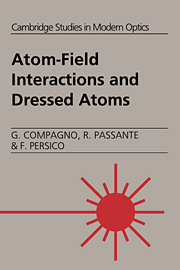Book contents
- Frontmatter
- Contents
- Preface
- 1 The classical electromagnetic field in the absence of sources
- 2 The quantum electromagnetic field in the absence of sources
- 3 The quantum matter field
- 4 Electrodynamics in the presence of sources
- 5 Atoms dressed by a real e.m. field
- 6 Dressing by zero-point fluctuations
- 7 Energy density around dressed atoms
- 8 Further considerations on the nature of dressed states
- Appendix A Multipolar expansion for the vector potential
- Appendix B Electric polarization and magnetization of the Schrödinger field
- Appendix C Rayleigh-Schrödinger perturbation theory
- Appendix D Sum rules for the nonrelativistic hydrogen atom
- Appendix E From Gauss system to SI
- Appendix F Gauge invariance and field interactions
- Appendix G Dressed sources in relativistic QED and in QCD
- Appendix H The energy-momentum tensor and Lagrangian density
- Appendix I The dressed relativistic hydrogen atom
- Appendix J The nonrelativistic Lamb shift in a hydrogenic atom
- Index
2 - The quantum electromagnetic field in the absence of sources
Published online by Cambridge University Press: 12 November 2009
- Frontmatter
- Contents
- Preface
- 1 The classical electromagnetic field in the absence of sources
- 2 The quantum electromagnetic field in the absence of sources
- 3 The quantum matter field
- 4 Electrodynamics in the presence of sources
- 5 Atoms dressed by a real e.m. field
- 6 Dressing by zero-point fluctuations
- 7 Energy density around dressed atoms
- 8 Further considerations on the nature of dressed states
- Appendix A Multipolar expansion for the vector potential
- Appendix B Electric polarization and magnetization of the Schrödinger field
- Appendix C Rayleigh-Schrödinger perturbation theory
- Appendix D Sum rules for the nonrelativistic hydrogen atom
- Appendix E From Gauss system to SI
- Appendix F Gauge invariance and field interactions
- Appendix G Dressed sources in relativistic QED and in QCD
- Appendix H The energy-momentum tensor and Lagrangian density
- Appendix I The dressed relativistic hydrogen atom
- Appendix J The nonrelativistic Lamb shift in a hydrogenic atom
- Index
Summary
Introduction. The purpose of this chapter is to present the quantum theory of the electromagnetic field in the absence of charges and currents. Thus the classical field discussed in the previous chapter is subjected to canonical quantization in Section 2.1, where creation and annihilation operators for plane-wave and spherical wave modes, as well as their commutation relations, are derived along with various field-field commutators related to field propagators. In the next section we introduce the concept of the photon as an elementary excitation of the electromagnetic field. The attention is focused on the ground state of the quantized electromagnetic field in the absence of sources, which is the photon vacuum. The amplitude fluctuations, or zero-point fluctuations of this vacuum, are evaluated. Excited states of the field are examined in the next sections. In particular, Section 2.3 is concerned with number states and coherent states, the latter being obtained by a Glauber transformation of the vacuum, and with their statistical properties. Squeezed states of the field are introduced in Section 2.4 by a unitary transformation leading from the normal to the squeezed vacuum, whose statistical properties are compared with those of a coherent state. Section 2.5 is devoted to a brief discussion of thermal states. The final section of this chapter is dedicated to a discussion of the nonlocalizability of the photon.
Information
- Type
- Chapter
- Information
- Atom-Field Interactions and Dressed Atoms , pp. 31 - 51Publisher: Cambridge University PressPrint publication year: 1995
